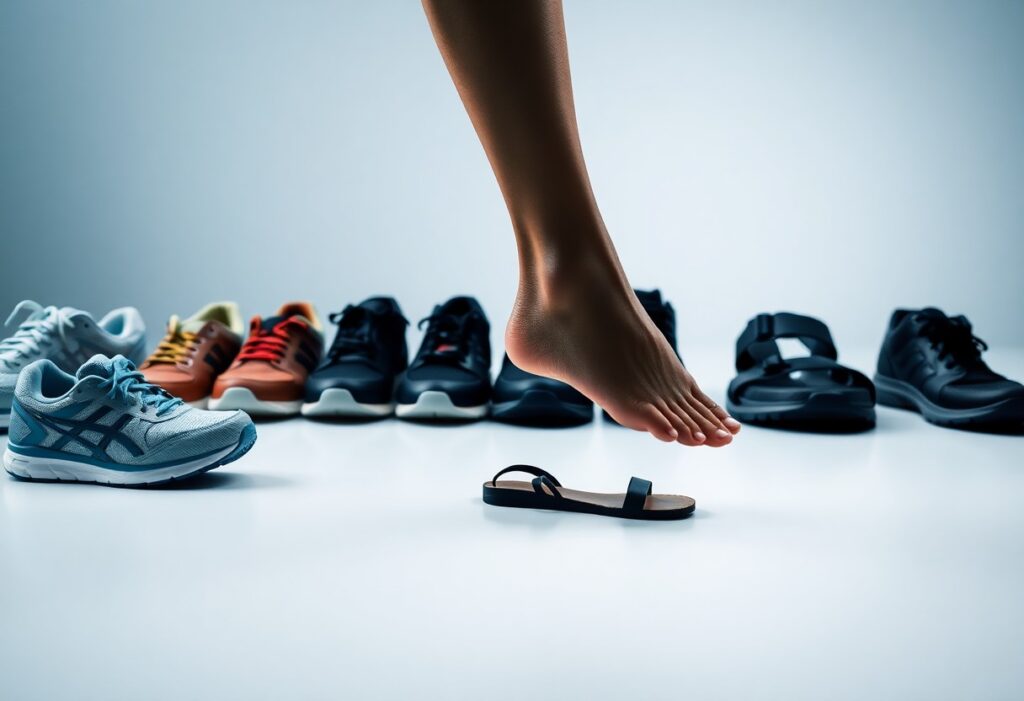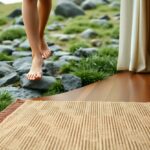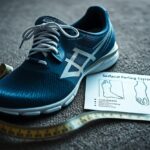
As you navigate through daily activities, the choice of footwear you make can play a pivotal role in either enhancing or undermining your overall foot health. While many people may assume that shoes with ample cushioning and support are the best option for alleviating foot discomfort, it's essential to recognize that conventional footwear can often lead to more harm than benefit. Dr. Alissa Kuizinas, a notable podiatrist from Massachusetts, advocates for the use of barefoot shoes or minimalistic shoes, positing that these types of footwear can contribute to stronger and healthier feet. By choosing shoes that allow your feet to function naturally, you can significantly reduce the risk of developing common foot ailments while promoting overall foot wellness.
Recognizing the Limitations of Conventional Footwear
Although traditional shoes may offer temporary relief from foot pain, they often exacerbate existing conditions and introduce new challenges, as highlighted by Dr. Alissa Kuizinas. She points out that the $133 billion shoe industry often prioritizes style and profits over genuine foot health, resulting in shoe designs that can constrict and weaken foot structure over time. This reliance on conventional footwear frequently creates a cycle of dependency that ultimately undermines your foot health, leading to a myriad of complications that could be avoided.
Examining the Shoe Industry's Misguided Focus on Foot Health
Central to this issue is the shoe industry's flawed approach to addressing foot health, which tends to emphasize the inclusion of excessive cushioning, support, and rigid construction in footwear while neglecting the root causes of discomfort. This misguided strategy can foster a dependence on conventional shoes that may progressively deteriorate your foot health, resulting in a range of complications that could have been prevented through more thoughtful design.
Spotting the Shortcomings of Traditional Shoe Construction
Many traditional shoe designs incorporate narrow toe boxes, rigid soles, and excessive cushioning that can impede natural foot movement, leading to weakened and dysfunctional feet over time. Dr. Kuizinas emphasizes that footwear should protect your feet from external elements rather than restrict their natural movements. A well-designed shoe should focus on facilitating natural foot function and embody minimalist attributes, such as wide toe boxes, flexible and flat soles, along with minimal cushioning, all of which are vital for promoting foot health.
By choosing to wear barefoot shoes or minimalistic footwear, you can actively work towards strengthening your feet and improving your overall foot well-being. Dr. Kuizinas recommends adopting the philosophy of using as little shoe as possible, which allows your feet to function naturally and move freely—an essential factor for maintaining healthy foot mechanics.
The Essential Importance of Natural Foot Movement
Footwear that limits your foot's capacity to move freely can lead to an array of foot issues and discomfort. It's crucial to assess how the shoes you select impact your overall foot health and comfort levels, as the right footwear can make a significant difference in your mobility and well-being.
Evaluating the Impact of Shoes on Foot Mobility
To fully understand the implications of your footwear choices, it is necessary to analyze the specific design and features of the shoes you wear. Traditional shoes often incorporate cushioning and support that can inadvertently restrict your foot's natural movement, contributing to weaker and dysfunctional feet over time. This limitation can inhibit your feet from developing the strength and flexibility they require to function optimally in daily activities.
Capitalizing on the Benefits of Natural Foot Mobility
The benefits of allowing your feet to move freely are extensive, as strong feet are foundational to overall foot health. By opting for minimalistic shoes or barefoot footwear, you empower your feet to function naturally, promoting strength and resilience. Movement is key to developing strong feet, and when restricted by conventional footwear, you risk encountering various foot problems and discomfort. In contrast, embracing minimalistic shoes or barefoot options can greatly improve your foot health by encouraging natural movement and facilitating strength development. By making informed footwear choices, you can reduce your risk of developing foot issues and enhance your overall foot wellness.
Delving into the Concept of Functional Footwear
Understanding the principles of functional footwear is essential, as these shoes prioritize both foot health and natural movement. Functional shoes are specifically designed to allow your feet to perform as intended, eliminating the need for excessive support or confinement.
Defining Functional Shoes and Their Distinctive Characteristics
Through research and experimentation with various shoe styles, you'll discover that functional footwear possesses unique characteristics, such as a wide toe box, flat and flexible soles, and minimal cushioning and support. These features enable your feet to move freely and naturally, fostering stronger and more capable foot mechanics that can significantly enhance your mobility.
Understanding How Functional Shoes Promote Foot Health
Wearing functional shoes provides numerous benefits, including improved foot strength, reduced risk of injury, and enhanced overall foot health. Functional shoes facilitate your feet in performing as they were designed, paving the way for stronger feet and better balance throughout your daily activities. Conceptually, functional footwear is crafted to support your feet without imposing unnecessary restrictions, allowing them to move and flex naturally. This design philosophy promotes optimal foot health and minimizes the likelihood of developing foot ailments. By selecting functional options like barefoot shoes or minimalistic choices, you actively encourage healthy foot function while reducing the risk of foot pain and injury. Transitioning to functional footwear may require patience and gradual adjustment, but the long-term benefits for your foot health are invaluable.
Recognizing the Key Features of Functional Footwear
To achieve the best possible foot health, it's vital to seek out shoes endowed with specific features. The primary attributes to consider include:
- Wide toe box
- Flat and flexible soles
- Minimal cushioning and support
Understanding these characteristics will significantly assist you in selecting footwear that promotes healthy foot function and support.
Comprehending the Significance of Wide Toe Boxes and Flexible Soles
A crucial aspect of functional shoes is a wide toe box that allows your toes to spread naturally. This design feature helps to prevent toe jamming and other discomfort-related issues that could result in chronic foot pain. By choosing shoes with a spacious toe box, you promote natural alignment and comfort, which is essential for overall foot health.
Recognizing the Importance of Minimal Cushioning and Support
In addition to a wide toe box, functional shoes should also feature minimal cushioning and support. This design element enables your feet to move naturally while enhancing muscle strength, thereby reducing the risk of foot issues. It's important to emphasize that minimalistic footwear, including barefoot shoes, can greatly benefit your foot health by allowing your feet to function freely. By opting for shoes with minimal cushioning and support, you strengthen the muscles in your feet and lower the chances of injuries. This strategic approach not only improves your overall foot health but also diminishes the likelihood of experiencing chronic pain. Therefore, you should prioritize footwear that facilitates natural movement without excessive cushioning or support.
Successfully Transitioning to Functional Footwear
Recognizing the significance of functional footwear is the first step; now it's time to embark on your transition journey. Contrary to the widespread belief that greater cushioning and support equate to enhanced comfort, you should favor minimalistic shoes or barefoot shoes that encourage your feet's innate functioning.
Helpful Tips for Transitioning to Functional Footwear
Despite any initial hesitations, begin integrating functional shoes into your daily routine by following these practical recommendations:
- Commence with short walks and gradually increase the distance
- Choose shoes with a wide toe box and flat soles
- Select minimal cushioning and support
The key is to allow your feet ample time to adjust to the new footwear while simultaneously strengthening the muscles in your feet.
Highlighting the Necessity for Patience and Gradual Adaptation
Transitioning to functional footwear requires patience and a thoughtful approach. Overly minimalist shoes may cause discomfort and pain if your feet are not accustomed to them; hence, starting slowly is crucial to allow your feet to acclimate to the new style of footwear. While barefoot shoes or minimalistic options can provide substantial benefits for foot health, it's essential to introduce them gradually. Overuse or improper fit can lead to injuries or ongoing discomfort. The ultimate goal is to enhance your foot muscle strength while improving overall foot health, so take your time and avoid rushing the process. The rewards of this transition will be considerable; anticipate experiencing improved balance, reduced pain, and stronger feet.
Building Strong and Functional Feet for Lifelong Health
Even in a world where footwear often emphasizes excessive cushioning and support, you can cultivate strong and functional feet by selecting appropriate footwear designed for your needs.
Understanding How Foot Strength Influences Overall Well-Being
Alongside various other health factors, foot strength plays a crucial role in your overall well-being, affecting your balance, posture, and movement capabilities. Strong feet contribute positively to your physical health, making it vital to prioritize their development through careful footwear choices.
Exploring the Benefits of Functional Footwear for Stronger Feet
Functionally designed shoes that feature a wide toe box, flat and flexible soles, and minimal cushioning are essential for developing strong feet, as they promote natural movement. Indeed, wearing functional shoes or barefoot shoes can significantly help in strengthening foot muscles and enhancing your overall foot health. By allowing your feet to move and operate naturally, you can reduce the risk of foot problems while optimizing your balance and stability. As you transition to minimalistic shoes, expect to see improvements in your walking technique and an overall enhancement in your well-being.
By taking control of your foot health, you can choose footwear that supports your feet' natural functions instead of hindering them. Selecting barefoot shoes or minimalistic options that facilitate your feet's natural operation will foster strength development over time. Consequently, you'll experience increased stability and comfort during various activities, allowing your feet to grow strong and capable. Begin your journey by seeking shoes with a wide toe box, flat and flexible soles, and minimal cushioning and support, and remain patient as you transition to a more natural walking style.
The Article A Podiatrist’s Guide to How Shoes Affect Your Foot Health appeared first on My Shoes Finder
The Article How Shoes Impact Your Foot Health: A Podiatrist’s Insights Was Found On https://limitsofstrategy.com






I really appreciate your insights on the importance of footwear for foot health. I’ve recently made the switch to minimalistic shoes after struggling with recurring foot pain for years, and I can already feel a positive difference. It’s fascinating how our traditional perceptions of “supportive” footwear can be misleading. I also think that embracing a more natural approach to movement can extend beyond just shoes—activities like yoga or even going barefoot on grass can help strengthen our feet in ways we’re not used to. I wonder how this philosophy could intersect with other health practices, like posture and overall mobility. Have any other readers found success with barefoot or minimalistic footwear? I’d love to hear your experiences!